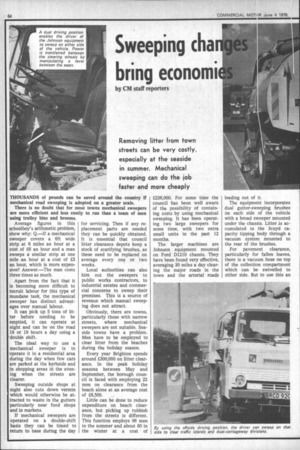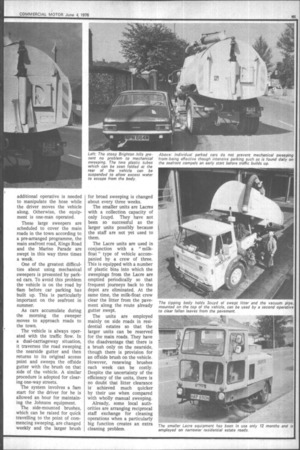Sweeping cha bring economi
Page 66

Page 67

If you've noticed an error in this article please click here to report it so we can fix it.
by CM staff reporters
Average figures in this schoolboy's arithmetic problem, show why: Q.—If a mechanical sweeper covers a 6ft wide strip at 6 miles an hour at a cost of £6 an hour and a man sweeps a similar strip at one mile an hour at a cost of £3 an hour, which is more expensive? Answer.—The man costs three times as much.
Apart from the fact that it is becoming more difficult to recruit labour for this type of mundane task, the mechanical sweeper has distinct advantages over manual labour.
It can pick up 5 tons of litter before needing to be emptied, it can operate at night and can be on the road 18 or 19 hours a day using a double shift.
The ideal way to use a mechanical sweeper is to operate it in a residential area during the day when few cars are parked at the kerbside and in shopping areas in the evening when the streets are clearer.
Sweeping outside shops at night also cuts down vermin which would otherwise be attracted to waste in the gutters particularly near food shops and in markets.
If mechanical sweepers are operated on a double-shift basis they can be timed to return to base during the day for servicing. Then if any replacement parts are needed they can be quickly obtained. It is essential that council litter clearance depots keep a stock of scarifying brushes, as these need to be replaced on average every one or two weeks.
Local authorities can also hire out the sweepers to public works contractors, to industrial estates and commercial concerns to sweep their premises. This is a source of revenue which manual sweeping does not attract.
Obviously, there are towns, particularly those with narrow streets, where mechanical sweepers are not suitable. Seaside towns have a problem. Men have to be employed to clear litter from the beaches during the holiday season.
Every year Brighton spends around £300,000 on litter clearance. In the peak holiday seasons between May and September, the borough council is faced with employing 22 men on clearance from the beach alone at an average cost of £6,500.
Little can be done to reduce expenditure on beach clearance, but picking up rubbish from the streets is different. This function employs 96 men in the summer and about 80 in the winter at a cost of £226,000. For some time the council has been well aware of the possibility of containing costs by using mechanical sweeping. It has been operating two large sweepers for some time, with two extra small units in the past 12 months.
The larger machines are Johnson equipment mounted on Ford D1210 chassis. They have been found very effective, averaging 30 miles a day clearing the major roads in the town and the arterial roads leading out of it.
The equipment incorporates dual gutter-sweeping brushes on each side of the vehicle with a broad sweeper mounted under the chassis. Litter is accumulated in the 3cuyd capacity tipping body through a vacuum system mounted to the rear of the brushes.
For pavement clearance, particularly for fallen leaves, there is a vacuum hose on top of the collection compartment which can be swivelled to either side. But to use this an additional operative is needed to manipulate the hose while the driver moves the vehicle along. Otherwise, the equipment is one-man operated.
These large sweepers are scheduled to cover the main roads in the town according to a pre-arranged programme, the main seafront road, Kings Road and the Marine Parade are swept in this way three times a week.
One of the greatest difficulties about using mechanical sweepers is presented by parked cars. To avoid this problem the vehicle is on the road by 6am before car parking has built up. This is particularly important on the seafront in summer.
As cars accumulate during the morning the sweeper moves to approach roads to the town.
The vehicle is always operated with the traffic flow. In a dual-carriageway situation, it traverses the road sweeping the nearside gutter and then returns to its original access point and sweeps the offside gutter with the brush on that side of the vehicle. A similar procedure is adopted for clearing one-way streets.
The system involves a 5am start for the driver for he is allowed an hour for maintaining the Johnson equipment.
The side-mounted brushes, which can be raised for quick travelling to the point of commencing sweeping, are changed weekly and the larger brush for broad sweeping is changed about every three weeks.
The smaller units are Lacres with a collection capacity of only lcuyd. They have not been so successful as the larger units possibly because the staff are not yet used to them.
The Lacre units are used in conjunction with a " milkfloat " type of vehicle accompanied by a crew of three. This is equipped with a number of plastic bins into which the sweepings from the Lacre are emptied periodically so that frequent journeys back to the depot are eliminated. At the same time, the milk-float crew clear the litter from the pavement along the route already gutter swept.
The units are employed mainly on side roads in residential estates so that the larger units can be reserved for the main roads. They have the disadvantage that there is a brush only on the nearside, though there is provision for an offside brush on the vehicle. However, renewing brushes each week can be costly. Despite the uncertainty of the efficiency of the units, there is no doubt that litter clearance is achieved much quicker by their use when compared with wholly manual sweeping.
Already, some local authorities are arranging reciprocal staff exchange for cleaning operations when a particularly big function creates an extra cleaning problem.




























































































































